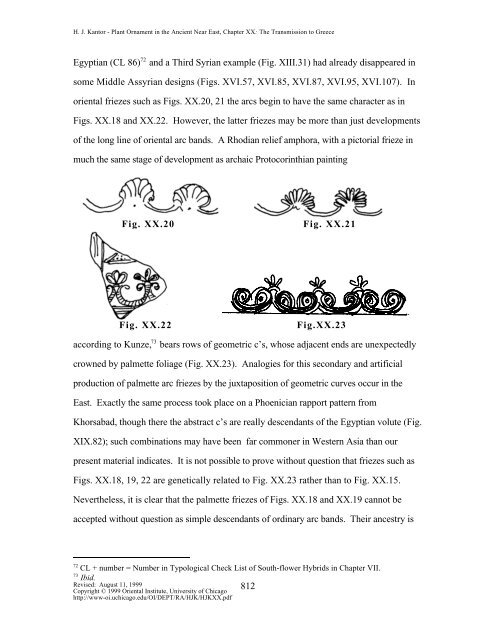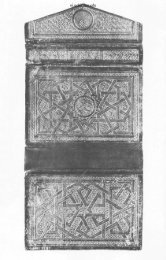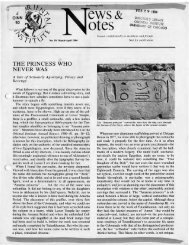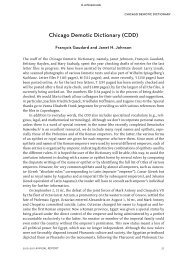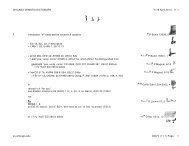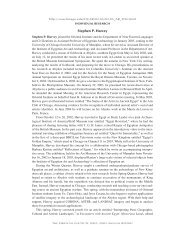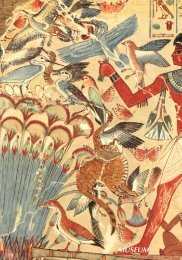chapter xx. the transition to greece - Oriental Institute - University of ...
chapter xx. the transition to greece - Oriental Institute - University of ...
chapter xx. the transition to greece - Oriental Institute - University of ...
You also want an ePaper? Increase the reach of your titles
YUMPU automatically turns print PDFs into web optimized ePapers that Google loves.
H. J. Kan<strong>to</strong>r - Plant Ornament in <strong>the</strong> Ancient Near East, Chapter XX: The Transmission <strong>to</strong> Greece<br />
Egyptian (CL 86) 72 and a Third Syrian example (Fig. XIII.31) had already disappeared in<br />
some Middle Assyrian designs (Figs. XVI.57, XVI.85, XVI.87, XVI.95, XVI.107). In<br />
oriental friezes such as Figs. XX.20, 21 <strong>the</strong> arcs begin <strong>to</strong> have <strong>the</strong> same character as in<br />
Figs. XX.18 and XX.22. However, <strong>the</strong> latter friezes may be more than just developments<br />
<strong>of</strong> <strong>the</strong> long line <strong>of</strong> oriental arc bands. A Rhodian relief amphora, with a pic<strong>to</strong>rial frieze in<br />
much <strong>the</strong> same stage <strong>of</strong> development as archaic Pro<strong>to</strong>corinthian painting<br />
Fig. XX.20<br />
Fig. XX.21<br />
Fig. XX.22<br />
Fig.XX.23<br />
according <strong>to</strong> Kunze, 73 bears rows <strong>of</strong> geometric c’s, whose adjacent ends are unexpectedly<br />
crowned by palmette foliage (Fig. XX.23). Analogies for this secondary and artificial<br />
production <strong>of</strong> palmette arc friezes by <strong>the</strong> juxtaposition <strong>of</strong> geometric curves occur in <strong>the</strong><br />
East. Exactly <strong>the</strong> same process <strong>to</strong>ok place on a Phoenician rapport pattern from<br />
Khorsabad, though <strong>the</strong>re <strong>the</strong> abstract c’s are really descendants <strong>of</strong> <strong>the</strong> Egyptian volute (Fig.<br />
XIX.82); such combinations may have been far commoner in Western Asia than our<br />
present material indicates. It is not possible <strong>to</strong> prove without question that friezes such as<br />
Figs. XX.18, 19, 22 are genetically related <strong>to</strong> Fig. XX.23 ra<strong>the</strong>r than <strong>to</strong> Fig. XX.15.<br />
Never<strong>the</strong>less, it is clear that <strong>the</strong> palmette friezes <strong>of</strong> Figs. XX.18 and XX.19 cannot be<br />
accepted without question as simple descendants <strong>of</strong> ordinary arc bands. Their ancestry is<br />
72<br />
CL + number = Number in Typological Check List <strong>of</strong> South-flower Hybrids in Chapter VII.<br />
73<br />
Ibid.<br />
Revised: August 11, 1999<br />
812<br />
Copyright © 1999 <strong>Oriental</strong> <strong>Institute</strong>, <strong>University</strong> <strong>of</strong> Chicago<br />
http://www-oi.uchicago.edu/OI/DEPT/RA/HJK/HJKXX.pdf


